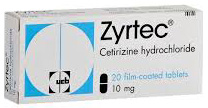Active Ingredient Details
Zyrtec, generically known as cetirizine, is an antihistamine medication. It is primarily used to relieve allergy symptoms such as sneezing, runny nose, itchy or watery eyes, and itching of the throat or nose. Cetirizine belongs to a class of medications known as second-generation antihistamines, which generally cause less drowsiness compared to first-generation antihistamines.
Mechanism of Action
Cetirizine works by inhibiting the action of histamine, a substance produced by the body during an allergic reaction. Histamine is responsible for causing allergy symptoms. By blocking the H1 histamine receptors in the body, cetirizine prevents histamine from binding to its receptors and thus alleviates allergy symptoms.
Formulations Available
Zyrtec is available in various formulations including tablets, chewable tablets, and liquid syrup. Tablets are typically taken once daily, with or without food. Chewable tablets offer an option for those who have difficulty swallowing pills. Liquid form allows for precise dosing in pediatric patients or those who prefer liquid medicine.
Common Indications
Zyrtec is commonly indicated for the treatment of allergic rhinitis (both seasonal and perennial) and chronic urticaria. Seasonal allergic rhinitis symptoms often occur due to pollen exposure, while perennial allergic rhinitis can be triggered by indoor allergens such as dust mites or pet dander. Chronic urticaria involves continuous or recurring episodes of hives lasting longer than six weeks.
Dosage Instructions
The usual recommended dose of Zyrtec for adults and children over 6 years of age is 5 to 10 mg once daily, depending on the severity of the symptoms and the individual’s response to the medication. In pediatric patients aged 2 to 5 years, the maximum recommended dose is generally 5 mg once daily. Dosage adjustments may be necessary in cases of renal impairment.
Specific Usage Guidelines
Zyrtec should be taken as directed by a healthcare professional. It is essential not to exceed the recommended dose to avoid increased risk of adverse effects. For individuals taking the chewable tablets, it is important to chew completely before swallowing. Those using liquid formulations should use the measuring device provided to ensure accurate dosing.
Pharmacokinetics Overview
After oral administration, cetirizine is rapidly absorbed with peak plasma concentrations occurring approximately one hour after dosing. It is primarily metabolized in the liver and excreted unchanged in the urine, reflecting its relatively low level of hepatic metabolism. Cetirizine has a half-life of approximately 7 to 9 hours in healthy adults.
Contraindications Overview
Zyrtec is contraindicated in individuals with known hypersensitivity to cetirizine or any of the excipients in the formulation. Additionally, patients with severe renal impairment should generally avoid using cetirizine due to reduced clearance and potential accumulation of the drug in the body.
Potential Drug Interactions
While cetirizine has a lower potential for drug interactions compared to first-generation antihistamines, it should be used cautiously with alcohol and CNS depressants due to additive sedative effects. Co-administration with theophylline may slightly decrease cetirizine clearance. Healthcare professionals should review a patient’s medication profile to identify potential interactions.
Pregnancy and Lactation
The use of Zyrtec during pregnancy should only occur if the potential benefits justify the potential risk to the fetus. Cetirizine is categorized as Pregnancy Category B, indicating no evidence of risk in human studies, though animal studies may indicate risk. Cetirizine is excreted in breast milk, so nursing mothers should weigh the potential benefits against potential risks to the infant.
Storage Requirements
Zyrtec should be stored at room temperature, away from excessive heat and moisture. It should be kept in its original packaging to protect it from light and humidity. As with all medicines, it should be stored out of the reach of children to prevent accidental ingestion.
Overdose Management
In case of Zyrtec overdose, symptomatic and supportive treatment should be initiated promptly. Activated charcoal may be considered if the overdose is recent. Physicians may monitor vital signs and ensure airway and breathing are maintained. Renal function should be assessed due to renal excretion of cetirizine, and in severe cases, dialysis may be an option for removal of the drug from the bloodstream.
Pediatric Considerations
Special precautions must be taken when administering Zyrtec to pediatric populations, particularly children under two years of age. Dosing should be carefully adhered to, considering the smaller body size and the different pharmacokinetic processes in children. Parents should be advised to use a calibrated measuring device for liquid formulations to ensure correct dosing.
Geriatric Use Considerations
Elderly patients may require adjusted dosages or monitoring because of potential age-related decreases in renal function. It is important to assess renal efficiency before initiating treatment to avoid the risk of accumulation and toxicity. Healthcare providers should also consider the increased sensitivity older adults may have to sedative effects.
Patient Counseling Points
Patients should be instructed on the possible side effects of Zyrtec, including drowsiness, fatigue, and dry mouth. They should also be advised not to operate heavy machinery or drive if they experience drowsiness from the medication. Patients should report any unexpected side effects or symptoms to their healthcare provider promptly for further evaluation.
Comparative Efficacy Information
Zyrtec is considered more selective for peripheral H1 receptors, resulting in less central nervous system penetration and fewer sedative effects compared to first-generation antihistamines. Studies have shown Zyrtec to be as effective as, or superior to, other second-generation antihistamines like loratadine in relieving allergy symptoms. The choice of antihistamine may depend on individual response and tolerance.




Reviews
There are no reviews yet.